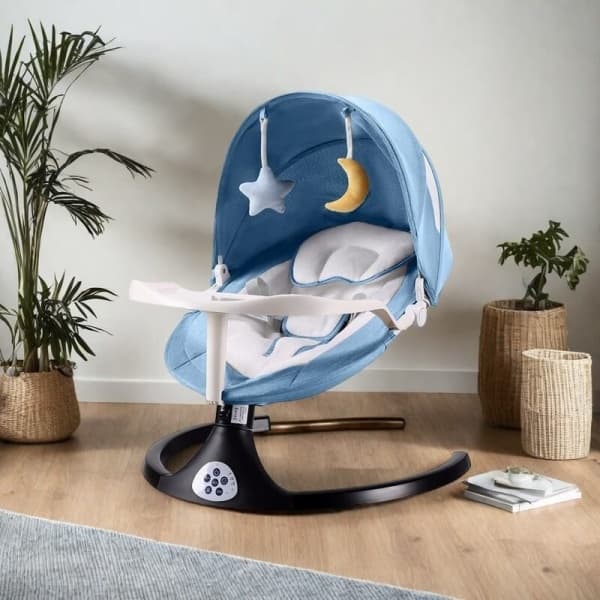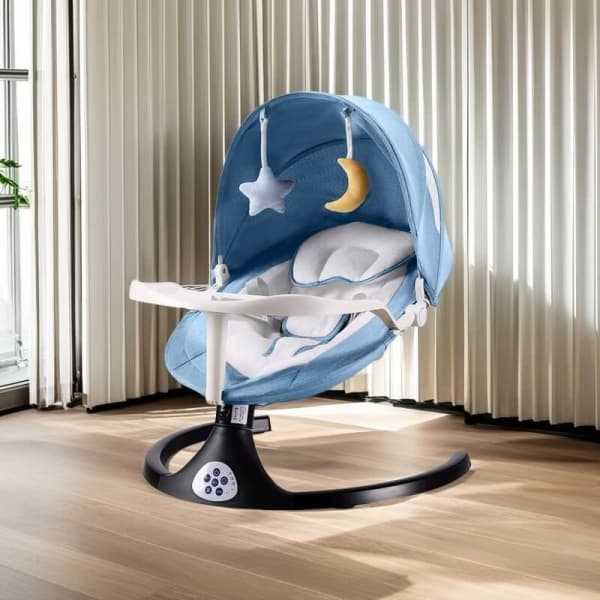At the infancy stage, the right height for a crib mattress is fairly simple to figure out. The mattress just needs to be high enough for the baby to be safe in the crib and for parents to easily pick up the baby.
However, as babies grow and become able to move independently, it is advisable to lower the crib mattress. It deters them from trying to climb out of the crib or rolling out of it in their sleep.
This then brings us to the vital question: when is the right time to lower the crib mattress? Is there a specific age? How much should you lower the crib mattress? Come along as we answer these questions and provide other helpful tips.
Why Is It Important to Lower the Crib Mattress?
Kids’ motor skills advance as they hit various milestones. They often start by sitting up independently but soon enough they learn how to stand with the support of the crib railing.
In both cases, if the crib mattress is high, it means that a baby’s height may exceed that of the crib railing when they sit up or stand. This makes it easy for the child to fall out of the crib or get tempted to try and climb out.
Such accidents are fairly common. Thousands of incidents and hundreds of deaths are reported each year in the U.S., mostly from injuries related to cribs, playpens, and bassinets. Notably, the most common cause of these injuries is falls, with the head or neck being the most frequently injured part of the body.
A study of medical data in the USA, for example, reveals that between 2012 and 2021, over 54,000 child emergency hospital visits were due to crib-fall-related head injuries.
These incidents are not always due to negligence. They, nevertheless, show why it is crucial to invest in a height-adjustable crib that you can position at safe heights as your child grows.
Different crib models have different numbers of crib height settings. Where possible, aim for cribs with more height levels. At least three to five height levels to be precise. Such cribs offer more options in terms of finding a safe comfortable height to position the crib mattress at different stages of a child’s development.
What is the Recommended Crib Height for Newborns?
Pediatric experts from the American Academy of Pediatrics, and other similarly trusted institutions, recommend the highest crib setting for newborns. This is based on two key considerations:
Newborns are not able to move much on their own. Therefore, there is no potent risk of them climbing or falling off the railing of a crib even when the crib mattress is high.
Setting the crib mattress high makes it easy for parents to comfortably pick up or put newborns to bed. More so considering mothers who need to nurse while still recovering from childbirth.
But even so, for newborns, the crib rails must be at least 26 inches above the mattress surface, even in the highest position, to meet safety standards.
When Should You Lower Your Baby’s Crib Mattress?

The right time to lower your child’s crib mattress is based on their development.
So, while experts recommend estimated timelines, it is best to pay attention to the skills your child is gaining as they grow. This, alongside the recommendations, will help you make the necessary adjustments at the right time.
That said, here is a breakdown of the different stages/milestones at which you should lower a child’s crib mattress.
Around 5 to 6 Months
Most babies begin to sit up independently and roll at around 5 to 6 months, and even start to sit up without help, around 5 to 6 months. They start to be curious about their surroundings and even try to get close to the crib rails after they have the ability to crawl.
If the crib mattress is left in the highest position, they are at a higher risk of falling out. Consequently, it is best to adjust the position of the crib mattress to the middle setting when you notice that a child can sit up or roll about.
Around 8 to 10 Months
Once babies master sitting up and rolling, they advance to attempting to stand while holding on to objects. The railing of a crib makes a perfect standing aid because it is stable. Most babies, therefore, quickly learn how to grip the slats and stand.
When this happens, take it as a sign to move the crib mattress from the middle setting to a lower level. Check that the top of the crib rails is at least three-quarters of the baby’s height when the baby is standing to ensure safety.
Around 12 months and Beyond
Most babies are quite active and adventurous by the time they get to 12 months. They can stand more independently or with support and have more control of their limbs and movements.
While some parents transition their children to a toddler crib at this stage, others continue to use a crib until the child reaches the manufacturer’s specified weight or height limit.
For toddlers still using a crib, the mattress should remain on the lowest setting.
How to Lower a Crib Mattress?
Lowering a crib mattress is relatively easy but if you have never done it before, it can seem rather daunting. Let’s run through some basic steps to demystify the process, shall we?
Step 1: The Instructions
Reading the crib manual of the crib you have can save you lots of time and frustration. Just because you have lowered a crib mattress on a different crib, do not assume you know how your current model works. Crib manufacturers are getting more innovative by the day and you may find that the current model has a much simpler solution.
Step 2: Identify the Right Setting
Examine the crib and identify the right setting to which you need to lower the crib mattress. Mark it if you need to.
Step 3: Empty the Crib
Take everything out of the crib including the mattress.
Pro tip: This may be a good time to deep clean the crib.
Step 4: Make the Adjustment
Most cribs have an adjustable mattress support frame or metal brackets on the inside. These frames or brackets usually have pre-drilled holes or holes that allow for different height settings. Determine your current setting and the desired lower position.
Step 5: Check for Stability and Levelness
Exert some weight on the crib to test and confirm its stability once you finish the adjustment. You could use a suitcase or any other suitable load as a substitute for your baby’s weight.
Confirm that the crib mattress support that you have adjusted is perfectly flat and even on all sides. If the base is uneven, the crib mattress will also be uneven which causes a risk of SIDs in infants and sleeping discomfort for kids of all ages.
Step 6: Re-dress the Crib
Once you confirm that the adjustment is well executed, clean up, return the mattress, and spread the crib bedding.
How to Choose a Crib Mattress?
When you start shopping for a crib mattress, you will certainly be spoiled for choice. There are a lot of brands to choose from, different mattress materials to consider, and various standards of quality. Here are the vital factors to consider when choosing a crib mattress.
Size
Check the size of your crib and the recommended mattress size for that crib. When you place the mattress in the crib, it should fit comfortably inside the crib. Experts recommend that the gap between the mattress and the crib rails should not exceed the width of two fingers.
On the other hand, in terms of density, the recommended thickness of a crib mattress is about 5.5 to 6 inches. A mattress that is too thick does not meet crib safety regulations because it may increase the likelihood that your baby will climb over the crib rails as he grows.
Firmness
Global sleep safety standards stipulate that crib mattresses be firm enough such that they do not compress or ‘cave in’ when you place the baby on the mattress.
A soft crib mattress or one that caves in under a baby’s weight increases the risk of sudden infant death during sleep. The compression of such a mattress can either cause suffocation or position the baby poorly as they sleep and cause airway obstruction.
Aim for mattresses with higher densities as they are usually firmer. Test them too to see whether they compress under weight.
Material and Breathability
Prioritize mattresses made using non-toxic materials. One way to confirm this is to look out for reputable certifications like a Greenguard Gold or a JPMA certification. Both of these certifications are only issued if a product meets the very high threshold that both organizations have against toxic chemicals.
Quality materials, like organic cotton, are a great advantage too as they are moisture-wicking and allow a good flow of air through the mattress.
Tips on When to Transition from a Crib to a Toddler Bed

The lowest crib setting may only serve you for a while. Especially considering the growth spurt that occurs after the 12-month mark. It is thus advisable to begin planning for a toddler bed once you reach the lowest crib height setting.
According to the APA, parents should move their children from cribs to toddler beds once babies are 35 inches tall. This is based on the fact that most crib railings will be too low to keep babies safe once they reach that height.
Other tell-tale signs that it is time to make the transition, include:
- Your baby frequently climbs or attempts to climb out of their crib.
- The crib becomes too small for the baby to have ample room to move around in their sleep.
Transitions should coincide with stable periods in your child’s life. Avoid making changes during major disruptions such as a move, a new sibling, or other major life events.
If you have a convertible crib, the transition is just as simple changing up the crib to a toddler bed. On the other hand, if your crib is not convertible, consider options like a Montessori floor bed or themed toddler house beds which make such transitions easier.
Conclusion
Ultimately, the decision about when and how much to lower a crib mattress depends on your baby’s needs and the abilities they acquire as they hit various milestones. If you pay attention to them and use the safety recommendations for reference, your decisions will be right on the mark.
Recommended Related Articles:














